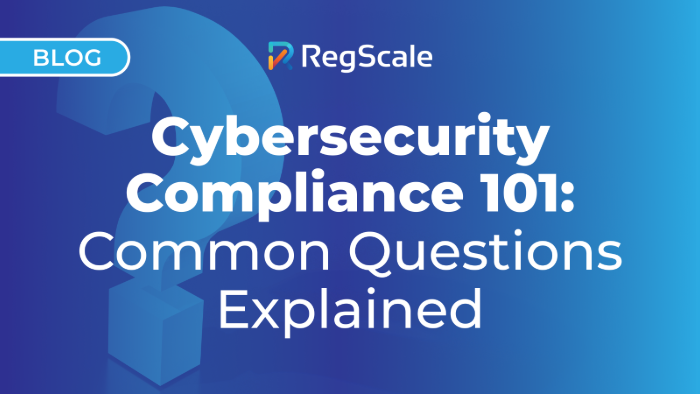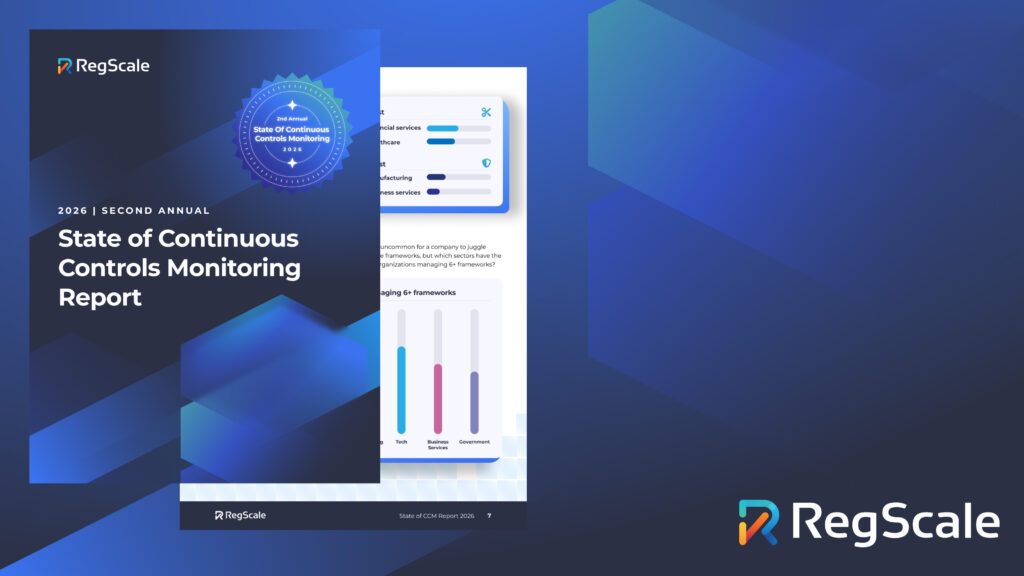
Cybersecurity compliance can feel like navigating a maze blindfolded. Whether you’re dealing with your first compliance audit, struggling to keep up with evolving requirements, or just trying to understand all the acronyms (HIPAA, PCI DSS, GDPR, FISMA), you’re not alone.
The good news? Cybersecurity compliance doesn’t have to be a constant source of stress and confusion. With the right understanding of key regulations and a strategic approach to building (and automating) your security program, you can turn compliance from a burden into a competitive advantage.
What is cybersecurity compliance?
Cybersecurity compliance is all about making sure your organization follows the rules for protecting sensitive data and IT systems from cyber threats. These rules come in the form of industry standards, regulations, and cybersecurity frameworks designed to keep information secure.
In simpler terms, cybersecurity compliance means aligning your company’s security practices with specific cybersecurity regulations that apply to your industry. Whether you’re dealing with protected health information (PHI), cardholder data, or critical infrastructure, these standards help businesses build a stronger defense against threats like data breaches, cyberattacks, and unauthorized access to sensitive information.
What does this entail, exactly? The cybersecurity compliance process typically encompasses several key components, including risk assessment, continuous monitoring, and the implementation of appropriate security measures. It also requires organizations to develop comprehensive security policies, maintain proper access control mechanisms, and establish incident response plans to address potential cybersecurity incidents.
But cybersecurity compliance isn’t just about ticking off boxes. It’s about building a long-term, proactive security program that can keep up with ever-evolving cyber threats and vulnerabilities. Frameworks like the ones from the National Institute of Standards and Technology (NIST) also give businesses a way to show stakeholders and regulatory bodies that they take information security seriously.
Falling short on compliance can lead to serious consequences. (Think fines, reputational damage, and greater exposure to cyber risks.) That’s why businesses in all sectors, from healthcare and finance to service providers, need to treat cybersecurity compliance as a top priority.
List of compliance regulations by industry
Different industries face different cybersecurity challenges. As a result, many different compliance standards have emerged to address specific risks and regulatory requirements. Let’s break down some of the most important cybersecurity regulations you’re likely to encounter based on your industry or business model.
FedRAMP (Federal Risk and Authorization Management Program)
If you’re thinking about selling cloud services to the federal government, FedRAMP is going to be on your radar. This program is a way for businesses to prove that their cloud platform is secure enough for government agencies’ sensitive data. It’s particularly crucial for service providers offering infrastructure, platform, or software solutions to government clients.
FedRAMP compliance involves rigorous security assessments based on NIST cybersecurity framework controls, continuous monitoring requirements, and regular audits. The process can take well over 18 months — although RegScale’s platform can accelerate FedRAMP package generation and submission significantly.
GDPR (General Data Protection Regulation)
The European Union’s GDPR has fundamentally changed how organizations worldwide handle personal data. Even if your business isn’t based in Europe, you’ll need to comply with the GDPR if you process personal information from EU residents. The regulation focuses heavily on data privacy rights, requiring organizations to protect personal data from breaches and unauthorized access.
What do you need to implement to comply with the GDPR? Clear consent mechanisms, data processing agreements, and the ability to delete or transfer customer data upon request. The regulation also mandates reporting data breaches within 72 hours, making incident response planning absolutely critical for maintaining compliance.
PCI DSS (Payment Card Industry Data Security Standard)
Anyone who accepts, processes, stores, or transmits credit card information needs to understand PCI DSS. This isn’t a government regulation; it’s actually a set of security requirements created by major credit card companies to protect cardholder data and reduce payment fraud.
The Payment Card Industry Data Security Standard includes twelve core requirements covering everything from firewalls and access control to regular security testing and vulnerability management. Depending on how many card transactions you process annually, you’ll fall into different compliance levels with varying requirements.
Non-compliance can result in hefty fines from card brands and increased transaction fees, making PCI DSS compliance essential for any business handling financial information.
FISMA (Federal Information Security Modernization Act)
FISMA applies to federal agencies and the organizations that work with them, establishing comprehensive requirements for protecting government information systems. If you’re a contractor working with federal agencies, you’ll likely encounter FISMA requirements as part of your contractual obligations.
Based on NIST standards, FISMA emphasizes risk management and requires regular security assessments, continuous monitoring, and documentation of security controls. The framework helps ensure that federal information and information systems are protected against cyber threats while maintaining the confidentiality, integrity, and availability of government data.
HIPAA (Health Insurance Portability and Accountability Act)
Healthcare organizations and their business associates must navigate HIPAA’s complex requirements for protecting health information. If you handle protected health information (PHI) in any capacity — whether you’re a hospital, insurance company, or cloud service provider working with healthcare clients — then HIPAA compliance will be non-negotiable.
HIPAA’s requirements include everything from employee training and access controls to encryption requirements and audit logs. Because healthcare data breaches can be so damaging, it’s essential to maintain patient trust and avoid regulatory penalties by implementing robust cybersecurity measures.
ISO 27001
ISO 27001 is an internationally recognized standard published by the International Organization for Standardization and used across industries. It provides a flexible framework that can be tailored to any organization’s risk profile and business requirements.
Many organizations pursue ISO 27001 certification as a competitive differentiator, especially when working with security-conscious clients or entering new markets where information security credentials matter. The certification process involves regular audits and demonstrates to customers, partners, and stakeholders that you take cybersecurity seriously.
How to improve your cybersecurity compliance program
So you’ve identified which compliance standards apply to your organization. Now what? Building an effective cybersecurity compliance program doesn’t happen overnight, but there are proven strategies that can help you strengthen your security posture while meeting regulatory requirements more efficiently.
Start with a comprehensive risk assessment
Before you can protect anything, you need to know what you’re protecting and where your biggest vulnerabilities lie. A thorough risk assessment will identify gaps between where you are and where you need to be, examining your information systems, data flows, and business operations to spot potential weak points.
Don’t try to tackle everything at once. Instead, prioritize your risks based on potential impact and likelihood. That database containing thousands of customers’ personal data? That’s probably higher priority than the break room’s smart TV. A risk-based approach will help you allocate resources more effectively and demonstrate to stakeholders that you’re making smart security investments.
Implement a robust cybersecurity framework
Rather than reinventing the wheel, leverage established frameworks like the NIST Cybersecurity Framework (CSF) to guide your security program development when possible. These frameworks provide a structured approach to identifying, protecting, detecting, responding to, and recovering from cybersecurity incidents. Essentially, they’re a roadmap that’s already been tested by thousands of other organizations. (The beauty of using a recognized framework is that it makes compliance easier across multiple standards when security controls overlap.)
Focus on continuous monitoring and improvement
Cybersecurity compliance isn’t a “set it and forget it” situation. Cyber threats evolve constantly, and your security measures need to keep pace. Implement continuous monitoring tools that can detect unusual activity, unauthorized access attempts, and potential security incidents in real-time. Once the right monitoring solution is in place, consider conducting quarterly reviews of your security policies and updating your risk assessments as your business grows and changes.
Invest in employee training and awareness
The reality is that your employees can be your strongest security asset or your biggest vulnerability. Most data breaches involve some element of human error, whether it’s falling for phishing emails, using weak passwords, or accidentally sharing sensitive information. Regular cybersecurity training will help your team recognize threats and understand their role in maintaining compliance.
Make sure that the training is also relevant and practical. Instead of generic cybersecurity awareness sessions, focus on the specific threats your industry faces and the compliance requirements that affect your staff’s daily work. Healthcare employees need to understand PHI protection, for instance, while retail managers should know about relevant PCI DSS requirements for handling cardholder data.
Establish clear security policies and procedures
Create clear, actionable security policies that cover everything from password management and access control to incident reporting and data handling procedures. Make sure these policies align with your specific compliance requirements. If you’re subject to the GDPR, your data retention policies need to address deletion requirements. If you handle credit card information, your access control policies must meet PCI DSS standards. The key is making these policies practical enough that employees can actually follow them consistently.
Leverage automation solutions
Manual compliance tracking is not only time-consuming; it’s also error prone. Modern compliance management platforms can help automate many aspects of your cybersecurity compliance program, from vulnerability scanning and controls monitoring to audit preparation and reporting.
Look for solutions that can integrate with your existing security tools and provide centralized visibility into your compliance status. The goal is to spend less time on paperwork and more time on strategic security improvements that actually reduce your cybersecurity risks.
Plan for incident response and recovery
Even with the best security measures in place, incidents can still happen. Having a well-documented incident response plan isn’t just a good idea; it’s often a regulatory requirement. Your plan should outline clear steps for detecting, containing, investigating, and recovering from security incidents.
Remember to test your incident response plan regularly through tabletop exercises or simulated attacks. When a real incident occurs, you don’t want to waste time figuring out who to call or what steps to take.
Streamline your cybersecurity compliance journey with RegScale
Let’s be honest: managing cybersecurity compliance can feel overwhelming. Between keeping up with evolving regulatory requirements, conducting regular risk assessments, maintaining security controls, and preparing for audits, it’s all too easy to get bogged down in paperwork and manual processes.
That’s where the right technology can make all the difference. RegScale’s GRC automation platform is designed to take the headache out of cybersecurity compliance by automating the heavy lifting. Our platform uses AI and automation to streamline manual tasks, delivering lower program costs and real-time insights while slashing paperwork. Our customers reduce audit prep time and effort by up to 60% and spend 92% less effort on writing control implementations with our AI model.
Ready to see how automation can revolutionize your approach to cybersecurity compliance? We’ve developed comprehensive resources to show how RegScale can help you move from compliance complexity to compliance confidence. Check them out here or schedule a call today.
Ready to get started?
Choose the path that is right for you!
Skip the line
My organization doesn’t have GRC tools yet and I am ready to start automating my compliance with continuous monitoring pipelines now.
Supercharge
My organization already has legacy compliance software, but I want to automate many of the manual processes that feed it.
